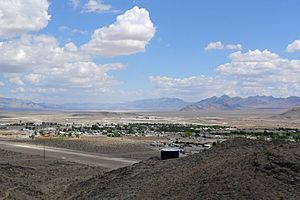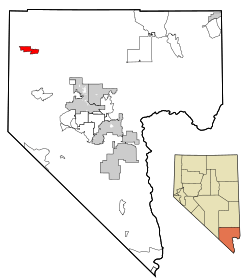Indian Springs, Nevada facts for kids
Quick facts for kids
Indian Springs
|
|
|---|---|
 |
|

Location of Indian Springs in Clark County, Nevada
|
|
| Country | United States |
| State | Nevada |
| County | Clark |
| Founded | 1906 |
| Named for | Native Americans and Spring |
| Area | |
| • Total | 18.04 sq mi (46.72 km2) |
| • Land | 18.04 sq mi (46.72 km2) |
| • Water | 0.00 sq mi (0.00 km2) |
| Elevation | 3,169 ft (966 m) |
| Population
(2020)
|
|
| • Total | 912 |
| • Density | 50.55/sq mi (19.52/km2) |
| Time zone | UTC-8 (PST) |
| • Summer (DST) | UTC-7 (PDT) |
| ZIP code |
89018
|
| Area code(s) | 702 and 725 |
| FIPS code | 32-35300 |
| GNIS feature ID | 0847373 |
| Website | Indian Springs Town Advisory Board |
Indian Springs is a small community in Nevada, located in Clark County. It's known as an unincorporated town, which means it doesn't have its own local government like a city does. Instead, it's managed by the county. Indian Springs is right next to Creech Air Force Base. In 2020, about 912 people lived there.
Contents
Discovering Indian Springs' Past
The name "Indian Springs" comes from the natural springs in the area. Long ago, Native American people settled near these springs. They used the water for their communities.
In 1906, Indian Springs became an important stop for the Las Vegas and Tonopah Railroad. It was a place where trains could get water. The original train tracks ran under what is now U.S. Route 95. The railroad stopped running in 1918.
From Army Airfield to Air Force Base
During World War II, a place called Indian Springs Auxiliary Airfield was quickly built. This happened right after the Pearl Harbor attack in 1941. It was used to train pilots for the United States Army Air Forces. They practiced air-to-air gunnery there. It also served as a backup airfield for the Las Vegas Army Airfield.
In 1947, both airfields were closed down. But just one year later, Indian Springs was reopened. It became Indian Springs Air Force Base. The new United States Air Force used it for testing new weapons and aircraft. This included supporting nuclear arms testing at the Nevada Test Site. They also tested experimental aircraft. In the 1950s and 1960s, Indian Springs AFB had some of the most advanced aircraft in the world.
In the 1960s, the base changed its name to Indian Springs Air Force Auxiliary Field. It became a training site for the USAF Thunderbirds, an elite air demonstration team. In 1982, a sad event called the "Diamond Crash" happened. Four Thunderbird pilots died in an accident. This led the team to switch from their T-38A Talon jets to the F-16C Fighting Falcon.
Creech Air Force Base Today
In 2005, Indian Springs Air Force Auxiliary Field was renamed Creech Air Force Base. It was named after General Wilbur L. "Bill" Creech. He was a former commander of the Tactical Air Command. In the 2000s, Creech AFB began to host the 432d Wing. This wing operates unmanned aerial vehicles, also known as drones. This brought the base back to its history of developing advanced aircraft.
The base is also home to other important squadrons. These include the 556th Test and Evaluation Squadron and the 99th Ground Combat Training Squadron. It also hosts parts of the Air Force Reserve and the Nevada Air National Guard.
The Story of "Wild Bill" Williams
Long ago, a ranch owned by George and Belle Lattimer was located where the Indian Springs Hotel & Casino once stood. In 1906, George Lattimer became very ill. Belle had to take him to the doctor. They left a 16-year-old Paiute boy named Coachie Siegmuller to watch the ranch.
While they were away, another Paiute man, known as Bill "Wild Bill" Williams, came to the ranch. Williams was known for taking advantage of young Paiute men. He would hire them out to ranchers and keep their earnings. Siegmuller was afraid of him. When Williams arrived, he lay down on the porch and fell asleep. Siegmuller felt he needed to protect the ranch. He took a rifle and, in fear, caused Williams' death.
Coachie Siegmuller was found responsible for Williams' death. He was initially sentenced to a severe punishment. However, the local Paiute Reservation spoke up. To maintain peace, Siegmuller's sentence was changed to three years in prison. The Lattimers buried Wild Bill Williams behind their ranch.
People and Life in Indian Springs
| Historical population | |||
|---|---|---|---|
| Census | Pop. | %± | |
| 2020 | 912 | — | |
| U.S. Decennial Census | |||
In 2000, there were 1,302 people living in Indian Springs. About 526 homes and 341 families were counted. The population density was about 68 people per square mile. Most of the people were White (88.02%). There were also smaller groups of African American, Native American, Asian, and Pacific Islander residents. About 6.84% of the population was Hispanic or Latino.
Many homes (32.1%) had children under 18 living there. About 44.3% of homes were married couples. The average household had 2.48 people. The average family had 3.05 people.
The population was spread out by age. About 29.0% were under 18. About 11.1% were 65 or older. The average age was 37 years old. For every 100 females, there were about 105 males.
The average income for a household was $40,966. For families, it was $40,608. About 10.7% of the population lived below the poverty line. This included 13.2% of those under 18.
Learning in Indian Springs
Indian Springs has a public library. It is part of the Las Vegas-Clark County Library District. This means residents can borrow books and use library services.
Indian Springs' Climate
Indian Springs has a desert climate. This is common in southern Nevada. It doesn't rain much throughout the year. Summers are very hot, but the air is usually dry. This makes the heat feel a bit less intense.
The climate here is similar to nearby Las Vegas. However, there are some differences. Nighttime temperatures in Indian Springs are much cooler than in Las Vegas. This is because Indian Springs is higher up. Also, it doesn't have the "Urban heat island" effect that keeps Las Vegas warmer at night.
| Climate data for Indian Springs, Nevada. (data from 1913–2012) | |||||||||||||
|---|---|---|---|---|---|---|---|---|---|---|---|---|---|
| Month | Jan | Feb | Mar | Apr | May | Jun | Jul | Aug | Sep | Oct | Nov | Dec | Year |
| Record high °F (°C) | 78 (26) |
82 (28) |
90 (32) |
97 (36) |
108 (42) |
118 (48) |
116 (47) |
114 (46) |
117 (47) |
100 (38) |
86 (30) |
83 (28) |
118 (48) |
| Mean daily maximum °F (°C) | 55.3 (12.9) |
60.7 (15.9) |
68.0 (20.0) |
78.0 (25.6) |
87.7 (30.9) |
97.1 (36.2) |
103.1 (39.5) |
101.2 (38.4) |
95.1 (35.1) |
81.1 (27.3) |
66.1 (18.9) |
57.9 (14.4) |
79.3 (26.3) |
| Mean daily minimum °F (°C) | 23.1 (−4.9) |
27.8 (−2.3) |
32.7 (0.4) |
42.0 (5.6) |
49.8 (9.9) |
57.2 (14.0) |
63.4 (17.4) |
61.4 (16.3) |
52.8 (11.6) |
41.4 (5.2) |
29.4 (−1.4) |
24.2 (−4.3) |
42.1 (5.6) |
| Record low °F (°C) | −5 (−21) |
3 (−16) |
13 (−11) |
21 (−6) |
26 (−3) |
38 (3) |
49 (9) |
40 (4) |
31 (−1) |
21 (−6) |
8 (−13) |
2 (−17) |
−5 (−21) |
| Average precipitation inches (mm) | 0.36 (9.1) |
0.27 (6.9) |
0.26 (6.6) |
0.33 (8.4) |
0.12 (3.0) |
0.11 (2.8) |
0.43 (11) |
0.29 (7.4) |
0.28 (7.1) |
0.25 (6.4) |
0.31 (7.9) |
0.28 (7.1) |
3.29 (84) |
| Average snowfall inches (cm) | 1.5 (3.8) |
0.2 (0.51) |
0.4 (1.0) |
0.1 (0.25) |
0 (0) |
0 (0) |
0 (0) |
0 (0) |
0 (0) |
0 (0) |
0.1 (0.25) |
0.4 (1.0) |
2.7 (6.9) |
| Source: The Western Regional Climate Center | |||||||||||||
See also
 In Spanish: Indian Springs (Nevada) para niños
In Spanish: Indian Springs (Nevada) para niños


